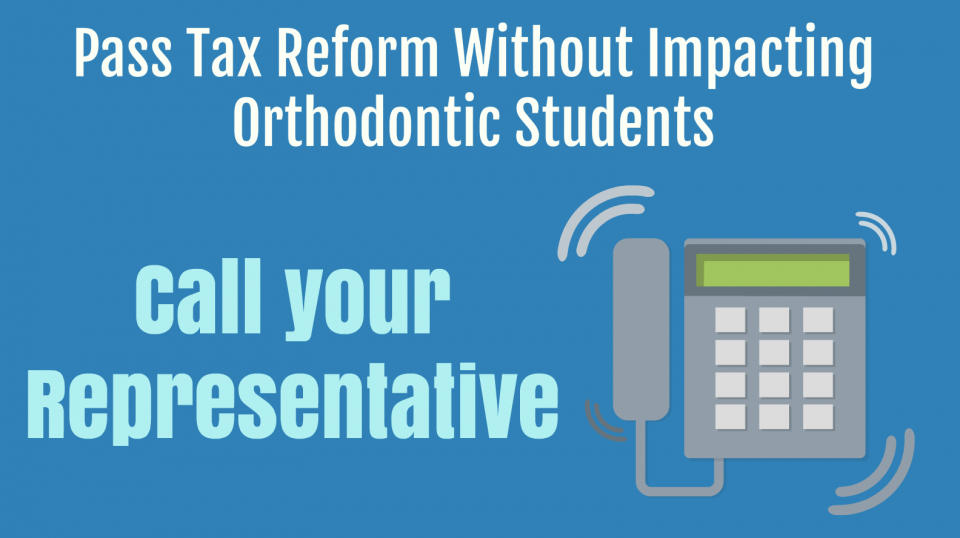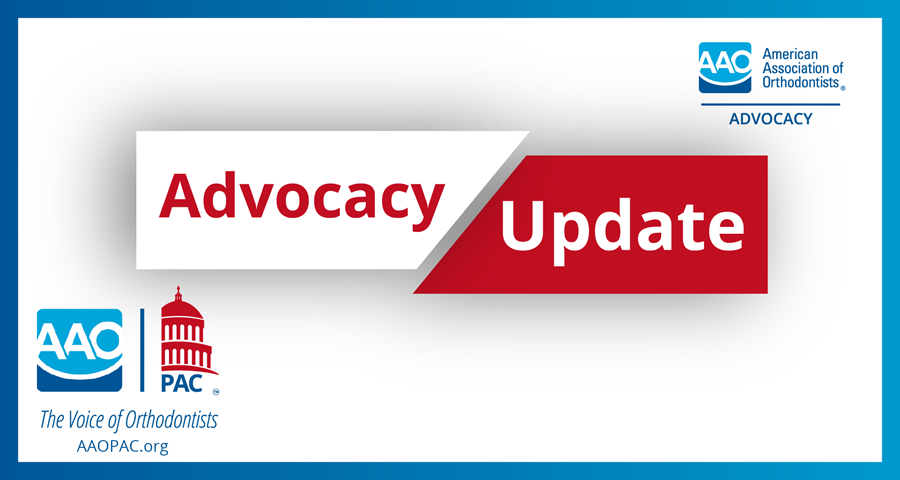Call Congress THIS WEEK to tell them not to use tax reform to make graduate medical education more expensive for the next generation of orthodontic students, or new doctors with outstanding student loans.
Congressional Action on Tax Reform
As Congress begins to work to resolve its differences between the House- and Senate-passed tax reform packages, the American Association of Orthodontists wants you to be aware of our ongoing advocacy efforts related to federal tax reform and encourage you to get involved. We are sending a letter to Senator Orrin Hatch (R-UT) and Representative Kevin Brady (R-TX), who will co-chair the conference committee working to resolve differences and agree on a final bill over the next week or so.
How it Impacts You
As you may know, the House Tax Cuts and Jobs Act (TCJA, H.R. 1) would eliminate several tax benefits which some of you may currently receive or have previously taken advantage of. The Senate bill does NOT have these three provisions, which include:
- Sec. 1201: Repeal of Lifetime Learning Credit (LLC), while not substantially increasing the American Opportunity Tax Credit (AOTC). The LLC provides a credit for 20 percent of up to $10,000 of qualified education expenses for postsecondary education. While there is no limit on the number of years the LLC may be claimed for each student, it does have an income phase out (between $56,000 and $66,000 and $112,000 and $132,000 for joint filers). The bill would eliminate the LLC while enhancing the AOTC slightly so that it would provide a 100 percent tax credit for the first $2,000 of certain higher education expenses and a 25 percent tax credit for the next $2,000 of such expenses. The AOTC would be available for a fifth year of post-secondary education at half the rate as the first four years.
- Sec. 1204: Repeal of the Student Loan Interest Deduction (SLID). H.R. 1 would repeal the above-the-line deduction for interest payments on qualified education loans for qualified higher education expenses of the taxpayer, the taxpayer’s spouse, or dependents. The maximum amount of the deduction is $2,500, and only taxpayers with certain modified adjusted gross income qualify (phases out between $65,000 and $80,000 for individual filers, and between $135,000 and $165,000 for joint filers for 2017).
- Sec. 1204: Repeal of Qualified Tuition Reductions. Under current law, qualified tuition reductions provided by educational institutions to their employees, spouses, or dependents are excluded from income. The exclusion may be provided in the form of either reduced tuition or cash. These may not apply to graduate programs, except for a graduate student who is teaching or a research assistant.
If your current tax status would be affected by these items, we understand your concern and are working to try to prevent the foregoing from becoming law.
While the House TCJA would double the standard deduction to $12,000 for individual filers (and $24,000 for joint filers), we understand that those of you who are affected are concerned about losing the benefits noted above. The Senate TCJA (S. 1) keeps intact each of the education benefits above while also doubling the standard deduction. In other words, the Senate bill is likely more favorable for orthodontic residents, students and young doctors with significant student loan debt.
What You Can Do
If you are impacted or concerned by any of the above provisions that would be eliminated in the House bill, we urge you to contact your Representative and Senators to ask that the final conferenced tax reform package retain the Senate language, which preserves important benefits for graduate students and recent graduates. Include how this impacts you and your family directly. Congress is in the final stretch to agree on a final bill, and your voice matters!
You can find your Senator, by clicking here: https://www.senate.gov/general/contact_information/senators_cfm.cfm
You can find your Representative, by clicking here: https://www.house.gov/representatives/find-your-representative
Do not hesitate to reach out to the AAO with any questions or if we can be of assistance – we are happy to help you get the word out. Below is a sample email/call template you can use for your outreach. Action should be taken before Friday December 8, if possible, as we expect the conferencing process to move quickly. We encourage a phone call as the best method of communication or you can send the sample email below.
###
SAMPLE TEXT FOR CONGRESSIONAL OUTREACH (if calling the Congressional office to relay this information, be sure to ask to speak to the staff member who handles tax issues, though you may have to leave a detailed message with the person at the front desk instead)
**Please personalize to tell your story.**
Good morning/afternoon/evening,
My name is ______, and I live in [city, state]. As the House and Senate work to resolve differences between their respective tax reform packages (H.R. 1 and S. 1), I urge you to retain the Senate language that protects graduate student and borrower benefits. These benefits currently make an enormous impact on my financial stability and ability to repay my loans. For example, I am an orthodontist/orthodontic resident and currently have $[enter student loan amount] in student loan debt. If I were no longer able to [deduct the interest paid on that amount/deduct a minimal amount of my graduate school costs/exclude from income my tuition waiver], it would compound the burden I already face with my current debt load. These benefits provide extra incentive to help me repay my loans sooner. Future borrowers may be dissuaded from entering the field altogether.
Thank you for your attention and I hope you will work to preserve these important student borrower benefits. If I can be of further assistance to you on these issues, please contact me at [phone number/email].
Sincerely,
[your name]



